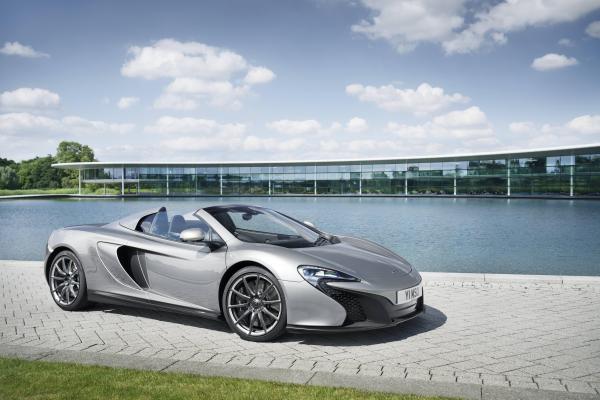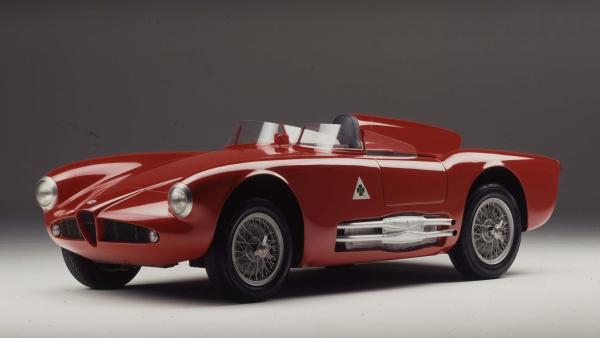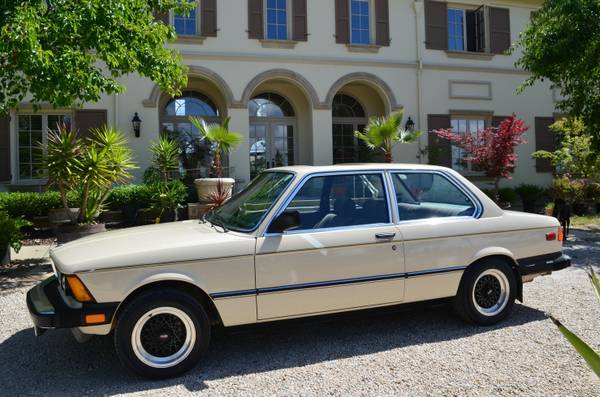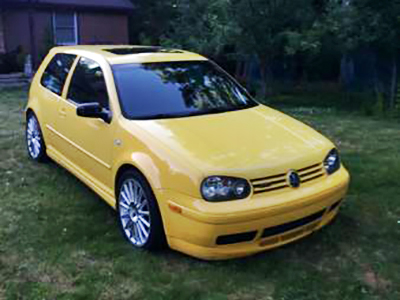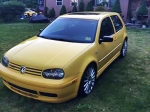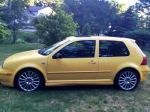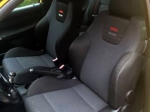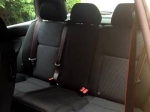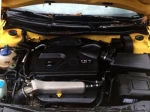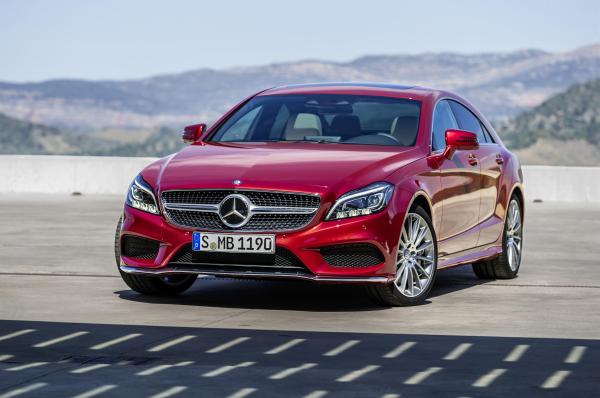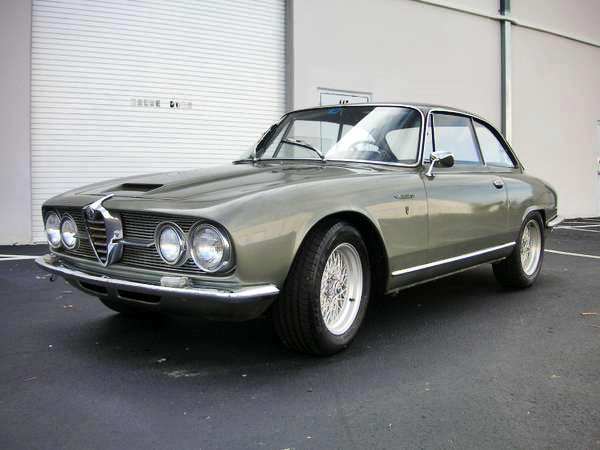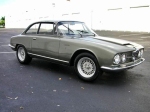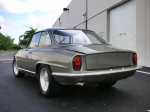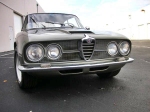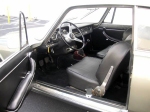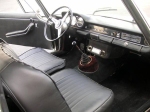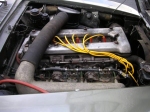Très tragoc. The 208 GTi 30th delivers a more intense driving sensation enhanced with a new Euro6 1.6-litre THP petrol engine developing 300Nm of torque and maximum power increased to a symbolic 208hp. Mated to a six-speed manual gearbox, it has exceptional traction and efficiency assured through the specification of a Torsen differential, specific suspension and steering settings.The exterior can also be distinguished with an optional paint finish – a coupe franche – where the rear is separated distinctively by a sharp dividing line from which the colours are cleanly divided.
Its sporty and assertive temperament can also been seen in its stance and look, in particularly by its dual-material livery, separated by a sharp dividing line. It will be presented to the public at the forthcoming 2014 Paris Motor Show, with sales starting in November 2014.
The 208 GTi 30th anniversary Limited Edition made its world debut on display with dynamic demonstrations at the Goodwood Festival of Speed – dynamically in the Supercar & ‘First Glimpse’ class on the Hillclimb at speed and on static display in the Moving Motor Show showroom – on Friday, Saturday and Sunday. It goes on public display at the next Paris Motor Show in October and will be going on sale in November 2014.
“As with any project of this type, there was a convergence of ideas and needs. Following on from the RCZ R, PEUGEOT Sport proposed that the Brand make a more radical version of the 208 GTi. At the same time the Brand thought about how best to celebrate 30 years of the PEUGEOT GTi in 2014.”
Maxime Picat – PEUGEOT Brand CEO.
A year after its commercial launch over 10,000 Peugeot 208 GTi Hatchback cars have been produced, confirming the success of the reinterpretation of the GTi icon and the strategy to offer a well-specified, performance sports model from PEUGEOT in the B Segment.
PEUGEOT has left its mark on the history of motor sport and DNA can be found in the genes of the 208 GTi, as in those of the RCZ, and its R version greatly enhanced by PEUGEOT Sport. As Peugeot celebrates 30 years since the original 205 GTi, it is now the turn for the 208 GTi to benefit from the expertise and racing pedigree of the engineers at Peugeot Sport. They have worked to give it a more radical character with what some call ‘extra soul’, in response to expectations by driving enthusiasts to have an authentic product with real capability.
A coherent exclusive signature with a more radical temperament
“The 208 GTi 30th builds on the virtues of a strong identity, great attention to detail and in the style of the 208 GTi, and takes on a more radical and brutish fashion, making the link with the incisive character of its dynamic performance,” Julien Kerlidou – Product Manager 208.
From the outset, the exclusive and more radical temperament shines through with the 208 GTi 30th. The suspension is lowered by 10mm, the track widened by 22mm at the front and 16mm at the rear, and larger wheels are specified giving it a pronounced sports car posture on the road.
The chic bright chrome finishers on the 208 GTi are replaced by matt black on the 208 GTi 30th, giving it a more brutish look. At the front the same treatment is applied to the grille surround, the fog lamp bezels and door mirror shells. From the side, the lowered stance is accentuated by matt black side skirts and wheel arch extensions that cover new 18″ wheels finished with matt black rims. The front wheels house large red PEUGEOT Sport labelled brake calipers. The window trim strip, which finishes with a signature paying homage to the illustrious 205 GTi, is also finished in matt black, while the quarter panel bears a ‘208 GTi 30th logo’. At the rear, the round twin chrome tail pipes ensure the sound of the new engine is fully expressed to enhance the aural driving experience.
Finally, the 208 GTi 30th could only be finished in colours that identify this sporting world. The interpretation uniting the red and black in a two-tone and dual material treatment is innovative and unique. The front is finished in a textured black, contrasting with the new high-gloss red at the rear. The two colours are divided by a sharp oblique straight-cut line (a ‘coupe franche’), as first seen on the Onyx Supercar Concept and reinterpreted on the 308 R and Exalt Concept cars. The 208 GTi 30th will also be available in Pearl White and Ruby Red – historical colours of PEUGEOT GTi cars.
Perfectly consistent with its exterior signature and dynamic character, the interior ambience has a more radical sports character developed for the 208 GTi 30th. The red fading to black finishers on the 208 GTi change to lacquered black. The black door handles with a red line echo the seat belts. High-quality floor mats are trimmed in red, while the front bucket seats are of a form specially developed by PEUGEOT Sport. These seats are trimmed in an exclusive blend of materials, mainly Alcantara, accompanied by black TEP with red stitching and a black dotted mesh pattern with red highlights.
A numbered plate marked ‘208 GTi 30th’ positioned above the courtesy lamp finishes off this limited edition anniversary model.
Unrestrained driving sensations for incisive behaviour on the road
“Based on the 208 GTi, itself already a very effective and well powered car, our ambition was to focus on behaviour on the road, by further increasing its effectiveness. For this we have developed the traction and a potential for more grip, mainly on the front axle. The benefits are essentially in passing speeds, driving sensations and feedback,” Pierre Budar –208 GTi 30th Project Manager.
The sensations begin when taking the wheel of the 208 GTi 30th. For the driver, familiarisation is simple and obvious as is directing the car. The compact steering wheel makes it easy to place the vehicle and enhances driving sensations. The instruments, positioned above the compact steering wheel, are directly in view. This facilitates the reading of information, which becomes instantaneous, without the driver having to take their eyes off the road.
Consistent with its specific dynamic character and pronounced driving sensations, this driving position is ideally complemented by a specific ‘bucket’ seat developed by PEUGEOT Sport. Together with the small wheel, the head-up instruments and feedback from the compact steering and suspension, it allows the driver to be at one with their car.
The new 1.6-litre THP engine, meeting the Euro 6 emissions standard, is fitted with Stop & Start. Its maximum torque is increased to 300Nm and maximum power to 208hp, an immediate reference to the model name. The power and torque are transmitted to the wheels via a six-speed manual gearbox with specific gear ratios, and a Torsen differential – both taken from the RCZ R, allowing the full potential of the vehicle to be exploited.
The ESP and traction control are recalibrated, so as to be less intrusive when driving and to set free the vehicle’s traction and allow the Torsen to operate. The advantage provided by the Torsen and the reduced anti-roll at the front are felt in particular when accelerating in a corner by maintaining tight trajectories, and when braking, with improving stability.
The lowered centre of gravity and redefined suspension geometry (wider track, camber angle, wheel alignment, 0.5’’ wider wheels) and the Michelin Pilot Super Sport 205/40 ZR 18 tyres optimise grip and ensure remarkable road holding.
The steering calibration has also been the subject of much development work, both on a track circuit and on the road. The objective was to obtain a linear level of assistance appropriate for the character of the car, taking account of the effect produced by the Torsen differential.
Associated with new damper settings and spring rates, as well as revised anti-roll, the steering is informative. All together it offers both precision and agility. The 208 GTi 30th can count on a braking system to match the performance achieved, with 323mm diameter and 28mm thick discs at the front and Brembo fixed four-piston calipers.
The sporty temperament of the 208 GTi 30th can also be seen in the figures: 0 to 62mph in 6.5 seconds and standing kilometre in 26.5 seconds. Mid-range acceleration is also of a high level with with 5th gear acceleration from 50 to 70mph possible in 6.0 seconds. Its performance and sharper handling are achieved with efficiency that is unprecedented in the segment, with CO2 emissions of just 125g/km.
The 208 GTi 30th again demonstrates that emotion, sportiness and efficiency are engrained in PEUGEOT’s heritage and genes


